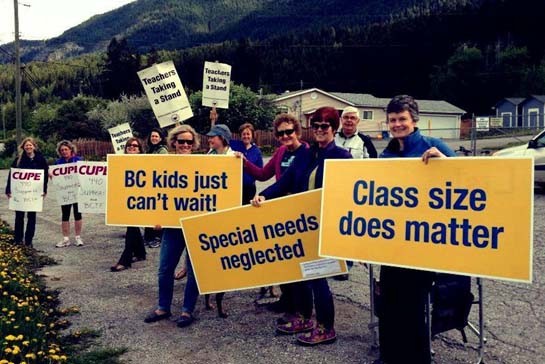I will never forget my first days teaching in a public school in British Columbia. It was 2004, and I had just left a job at a small private girls school to work in a large public high school. I went from class sizes of about 18 to class sizes of over 30. From a school where the adult-to-student ratio was one to eight, to a school where sometimes I wondered where the adults were. From quiet to loud, spacious to cramped, clean to messy, orderly to chaotic, easy to hard. That is how much my job changed.
I left for philosophical reasons. I believe in public schools and had always wanted to teach in the public system. I took some risk leaving my private school position, which was almost full time, and unionized, with decent pay and benefits, and where many of my classes had between 15 and 18 students. I left to join the on-call list in a public district and was lucky enough to land a half-time contract after six months.
Looking back at that dream job, I sometimes wonder why I let my principles get the best of me. I had my own classroom -- a computer lab. I had a full-time technical support worker assisting me when needed. Spring break was two weeks and Christmas break was three. And I had lots of fun on the fall "out trip," where I was paid to introduce the students to the sites of Victoria.
I USED TO HAVE TIME TO TEACH
"Classroom management" was a distant, unnnecessary memory from a course I had taken. My students were well-behaved, engaged, and motivated. I didn't have a single student requiring adaptation for an Individual Education Plan, and my English as Second Language students all received tutoring, assistance and regular ESL classes. That was not something I had to worry about. I had the luxury of devoting all of my non-teaching time to lesson preparation, learning new ideas and teaching techniques that I could introduce to my students, and careful assessment of student work.
The contrast between my private school job and my first public school position could not have been more stark. In the public school, there were crowded hallways, constant disruptions in class, challenging behaviours, and many students behind grade level, with learning difficulties. I recall walking down the main hallway, where students congregated and ate their lunch, and being taken aback by the crowded space, and, most noticeably, the total and complete lack of adults.
At the private school, there had been an adult-to-student ratio of one to eight. This meant there was never a time, in my recollection, that any public space had fewer than two adults in it. In the public high school, crowded hallways were often devoid of any adult presence. Once, in the main entryway to the school, I encountered four students engaged in a physical fight, surrounded by about 100 of their peers. As I descended the upper stairwell to the school lobby, I looked around and couldn't see a single other adult. It was my good fortune that three of the four students fighting knew me, and so I felt confident to intervene. Otherwise, I would have been
scared.
There was a lot of bad behaviour in the hallways at break time: homophobic put-downs, inconsiderate remarks, throwing garbage on the floor. But, one of the things I learned very quickly at my new job was that, if I stopped to intervene every time I encountered an incident, I would never make it to the lunchroom to eat. And so I, like many other worn-out and harried teachers, intervened when it was essential, but learned to ignore the student throwing the gum wrapper on the floor. After a time, you get acclimatized and it all starts to feel normal.
{media_3}WE NEED SMALLER CLASSES
Inside the classroom, the difference between the private school and public school atmosphere was just as palpable. In my new position, I found that at least a third of my attention was always needed to monitor student behaviour. Of my daily utterances to students, many were now in the "sit down," "please be quiet," "I need your attention" variety. There was, by necessity, a seismic shift in my focus, from students' needs to students' behaviour. My after-class hours were consumed with meeting students to provide individual help, seemingly endless stacks of marking, and trying to figure out how to teach the student with elementary-level reading skills in my Grade 9 class, or the student who was barely there and traumatized by a family death, or the student with mild intellectual disability who required a whole different curriculum to meet his needs. Precious little time was left for learning new technologies, revamping my lessons, or planning field trips. With 210 students on my roster per year, that just wasn't possible.
Few with any experience in our school system would dispute the benefits of smaller classes, and of ensuring that each class has a manageable number and range of students with special needs. The simple reality is that as class sizes grow, adult attention per student diminishes, and student behaviours are harder to manage. Some point to the past, when class sizes were 40 or even 50 students, as a way to say class size doesn't matter. Those were also the times of the strap, and when students with disabilities were housed in segregated facilities. Is that where we want to go?
If we want a caring, nurturing, safe environment in schools, we need adequate adult supervision. If we want teachers to be able to devote their time to teaching and learning activities, we can't overwhelm them with oversized classes. Again, the math is simple: if we double the size of an Grade 12 English class, the teacher will need to halve the number of essays each student writes for feedback, because there are only so many hours on the weekend to do the marking. In an 80-minute math class, after going over homework and through the daily lesson, there are only 30 minutes left. That is one minute per child, in a class of 30. No wonder parents who can afford it hire tutors.
But class size isn't the only difference. Last summer, my daughter went to summer camp at St. Michael's University School. A private school, it doesn't have a building, it has a campus. The beautiful, landscaped gardens include hanging flower baskets. The music room is stocked with instruments and designed for its purpose. The grounds include a nice, outdoor amphitheatre. It is well-funded.
THE CHILDREN WHO NEED THE MOST GET THE LEAST
Yes, I believe I deserve a raise. But, just like other teachers, that isn't the main reason I voted yes to strike. A society is measured by how it treats everyone. This includes the poor, the disenfranchised, the "ordinary." In British Columbia, children of poor and working-class families get overcrowded in underfunded schools. The children who need the most from education -- the hungry, the hurt, the struggling ones -- get the least. In contrast, the ones whose parents can pay get the most.
The "public" in public school shouldn't mean just providing a building, with some tired teachers to deliver a curriculum, the success of which is measured by standardized tests. A good public school system should provide high quality opportunities to every single child. While our public schools have many wonderful programs and many dedicated teachers, the sad truth is that there are also overcrowded classrooms, children falling behind, and a workforce exhausted from trying to fill in the gaps.
Class-size provisions, which were illegally removed from our collective agreements in 2002, are only a fraction of what is needed to move towards a genuinely high quality public education system. But they are a necessary start. I hope we stay on the picket line long enough to win them back, and I hope parents and citizens who want the best for every child join us in this struggle.











